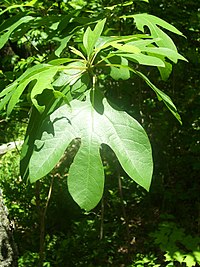
Photo from wikipedia
Ambrosia beetles require their fungal symbiotic partner as their cultivated (farmed) food source in tree galleries. While most fungal-beetle partners do not kill the host trees they inhabit, since their… Click to show full abstract
Ambrosia beetles require their fungal symbiotic partner as their cultivated (farmed) food source in tree galleries. While most fungal-beetle partners do not kill the host trees they inhabit, since their introduction (invasion) into the United states around ~2002, the invasive beetle Xyleborus glabratus has vectored its mutualist partner (but plant pathogenic) fungus, Harringtonia lauricola, resulting in the deaths of over 300 million trees. Concerningly, indigenous beetles have been caught bearing H. lauricola. Here, we show colonization of the mycangia of the indigenous X. affinis ambrosia beetle by H. lauricola. Mycangial colonization occurred within 1 h of feeding, with similar levels seen for H. lauricola as found for the native X. affinis-R. arxii fungal partner. Fungal mycangial occupancy was stable over time and after removal of the fungal source, but showed rapid turnover when additional fungal cells were available. Microscopic visualization revealed two pre-oral mycangial pouches of ~100-200 × 25-50 μm/each, with narrow entry channels of 25-50 × 3-10 μm. Fungi within the mycangia underwent a dimorphic transition from filamentous/blastospore growth to yeast-like budding with alterations to membrane structures. These data identify the characteristics of ambrosia beetle mycangial colonization, implicating turnover as a mechanism for host switching of H. lauricola to other ambrosia beetle species.
Journal Title: Environmental microbiology
Year Published: 2023
Link to full text (if available)
Share on Social Media: Sign Up to like & get
recommendations!